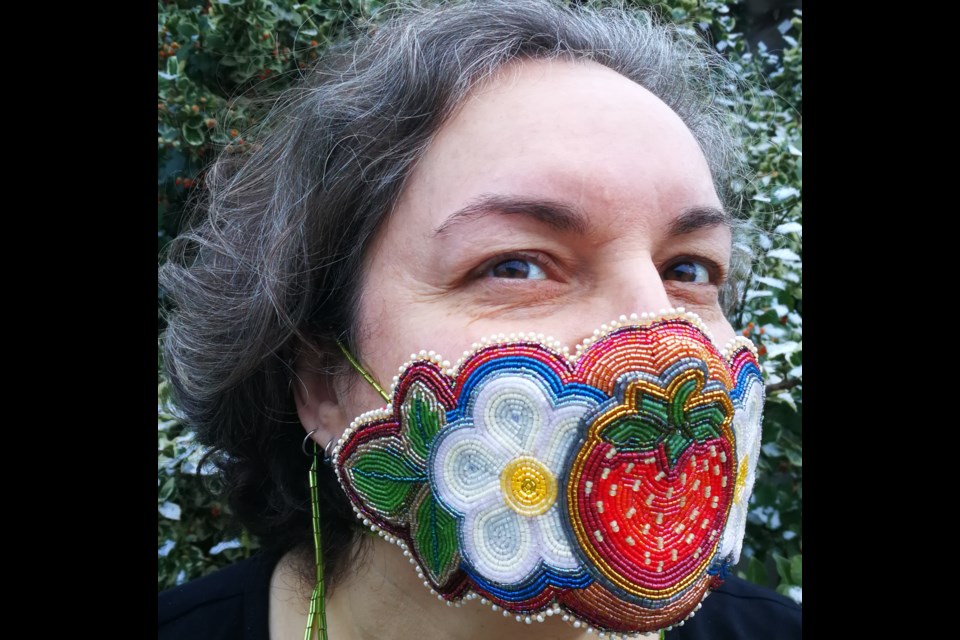What started as an idea in one Newmarket artist's workshop has grown into a massive art project involving more than 1,000 artists from countries worldwide that has caught the attention of prominent museums such as the Smithsonian Instituition in Washington.
The Breathe project has been capturing the ethos of the COVID-19 era by creating elaborate beadwork face masks as art pieces. The project was the brainchild of Newmarket Metis artist Nathalie Bertin and her British Columbia counterpart, Lisa Shepherd. But Breathe has grown much faster and larger than the founders could have anticipated.
When asked why the project exploded in the way it has, Bertin believes that it offered the artists involved a chance to connect with one another during a time of hardship.
"I think people need to connect, and the pandemic took that away from a lot of us. We are seeing now, in the second wave, that a lot of people are refusing to abide by the rules because they need to connect," she said. "I think the project's Facebook group gave people a chance to share their stories and explore their emotions. It is a safe space."
Bertin is a professional working artist in a variety of media and has lived in Newmarket since the early 2000s. She said the idea to get artists together to create beadwork face masks came from an offhand remark from her husband.
"The Metis are historically known for our beadwork. When I say we will bead everything, I mean we will bead everything," she said. "My husband asked me if anyone had beaded any masks yet, and I said I hadn't seen any. As a lark, I put it on Facebook saying, 'where are all the beaded masks?'"
"My friend, Lisa Shepard, who works as a traditional artist in B.C. emailed me right away saying she had thought about doing a mask but was feeling (creatively) blocked. After some talk, we ended up creating the Facebook group. That was the beginning."
Indigenous artists were invited to join the group to create beaded face masks in their own culture's style and materials. It could be any kind of mask, but no one could take a real PPE needed by frontline workers; they had to be made from scratch.
It wasn't long before they decided to open up the project to artists of all backgrounds, not just Indigenous, because the pandemic affects all people. The resulting masks were not usable for protection out in public, but they were dazzling pieces of art that told a story about the culture and emotions of the artist who created it.
"Two of my favourites are masks are by a Chinese artist in Ottawa, Don Kwan, whose family owns restaurants, and he made masks out of the menus. They are fabulous. Such a simple idea that speaks to how racism has emerged during the pandemic in the form of blaming the Asian community," said Bertin.
"We started getting these letters from people saying how making a mask had been healing for them, and how it helped them move on with their artistic practice or whatever else they did in life. That was super rewarding."
As time went on, they heard that museums in the United States had begun buying the masks for their collections, including the famous Smithsonian in Washington, D.C.
Bertin said it made them wonder why no Canadian galleries had expressed interest. So they decided to bring several of the masks together for an exhibition.
By the summer, the Whyte Museum of the Canadian Rockies in Banff, Alta. was asking to host their exhibition. Other galleries and museums in Canada also began to express interest. Eventually, 45 masks from Canadian artists were chosen for the show, which is travelling around the country.
A second exhibition is in the final stages of being put together, with the masks currently being juried at the Art Gallery of Guelph. A grand finale to the project is also being planned for 2022 when both exhibits will be brought together.
"We've had a lot of interest from galleries, and it's been a lot of work. It's basically taken over my life. It has been amazing and fulfilling, but it's totally grassroots; we haven't made any money off this. So I still have to find time to look after my own career," said Bertin.
When asked what she believes the project will be able to tell future generations about the age of COVID-19, Bertin said it's hard to envision the future when we are still in the thick of the pandemic. But does say there is plenty of interest in preserving the pieces.
"One of our major museums here in Ontario has expressed interest in buying the whole collection. We are recording a moment of history through these masks; I would like to think that 10 or 15 years from now, people will be able to see these masks again. I don't know, I hope it lives on."



